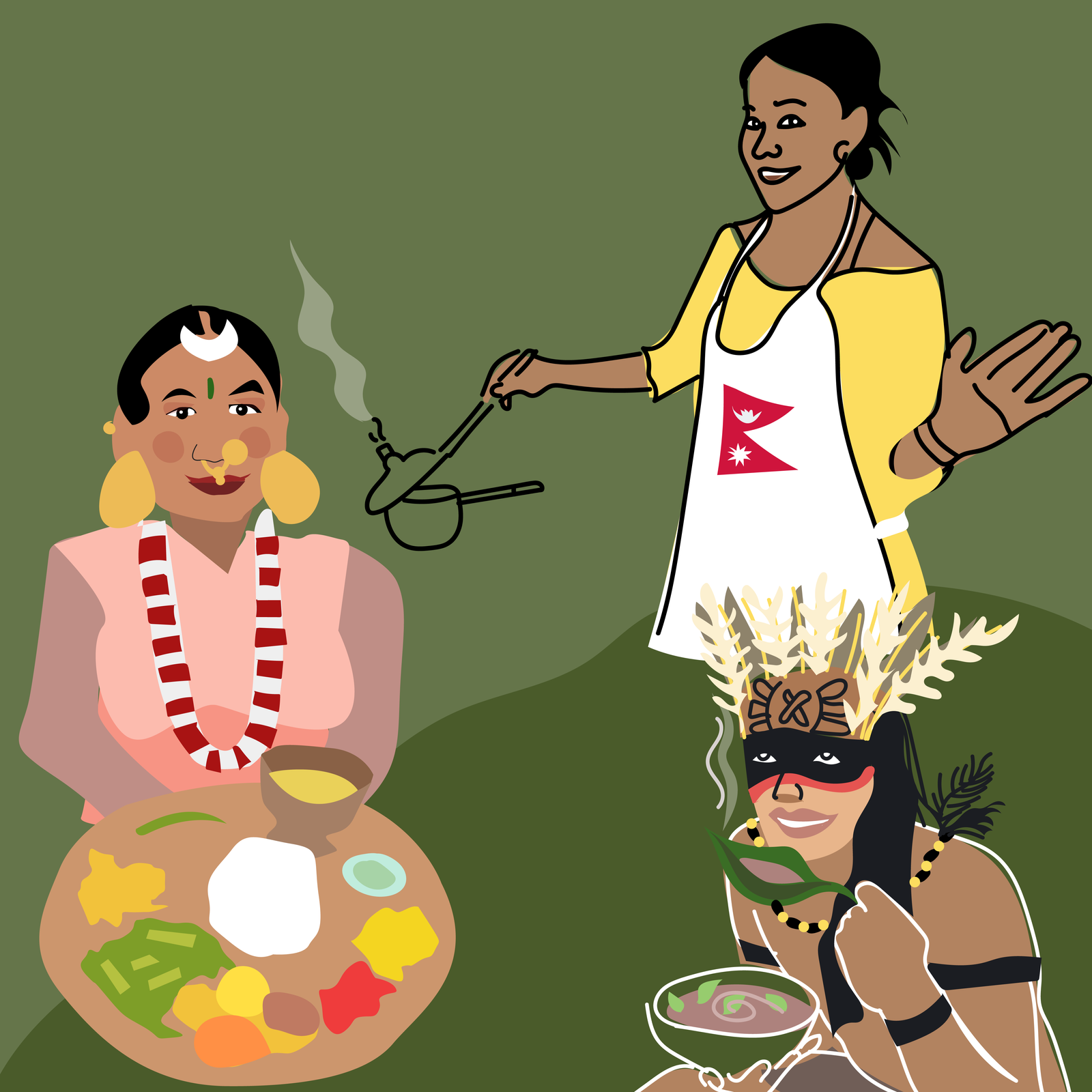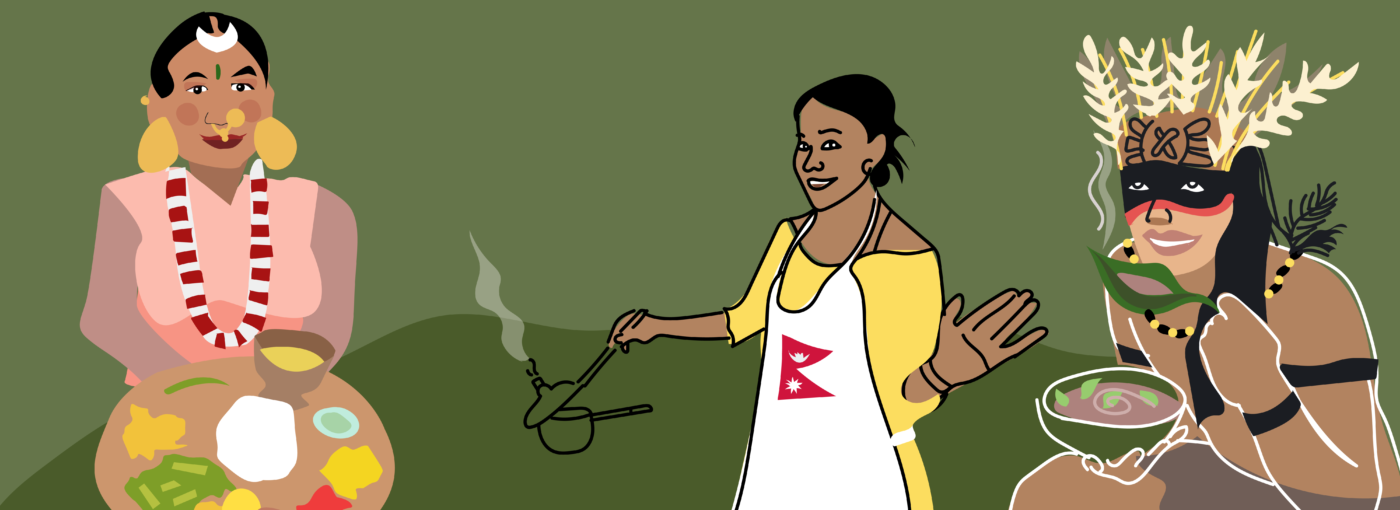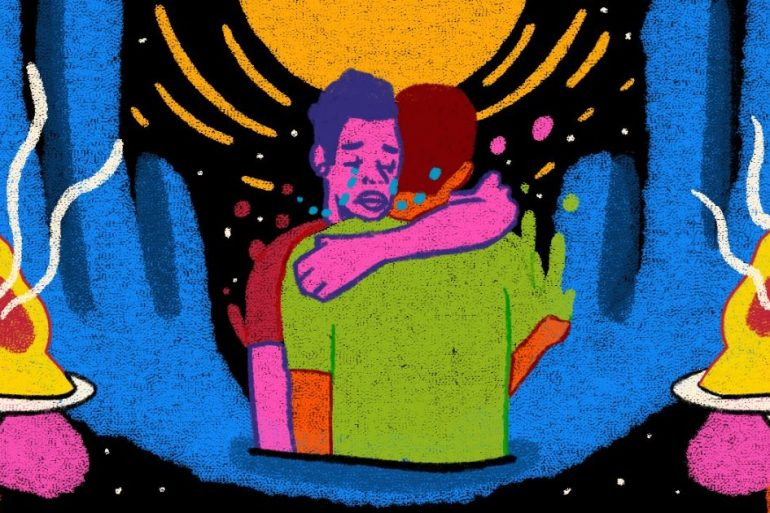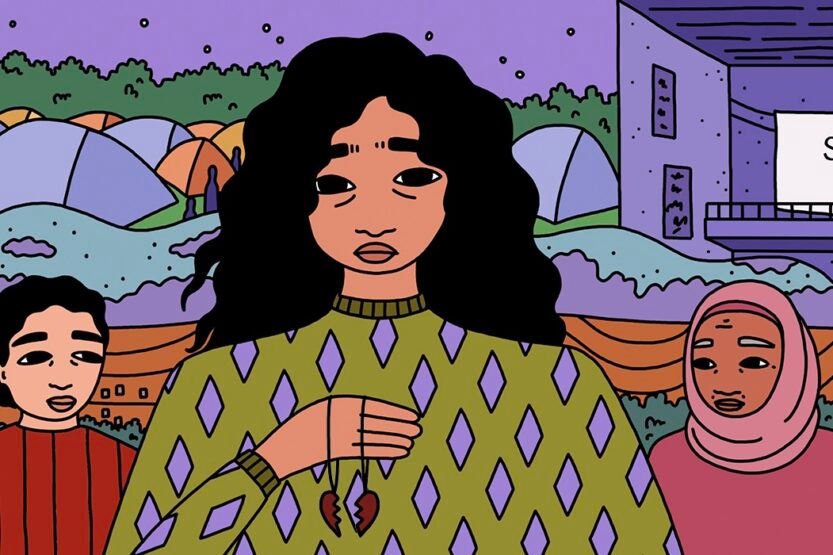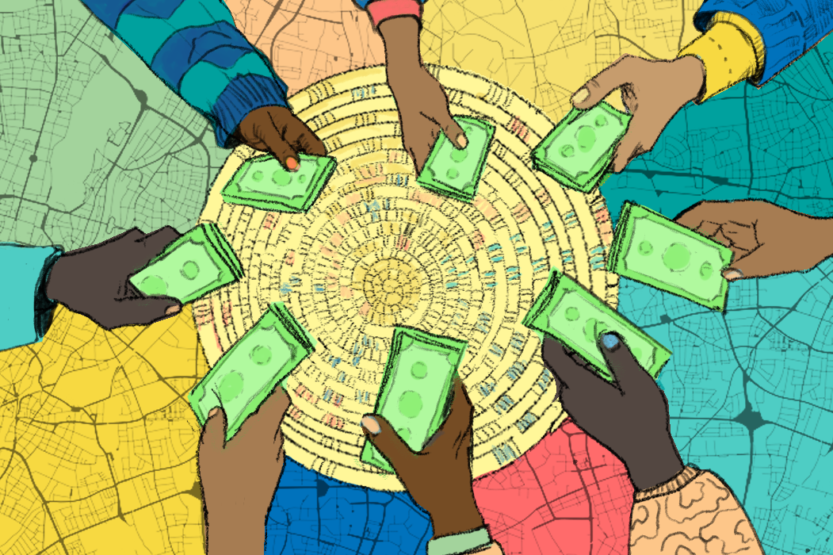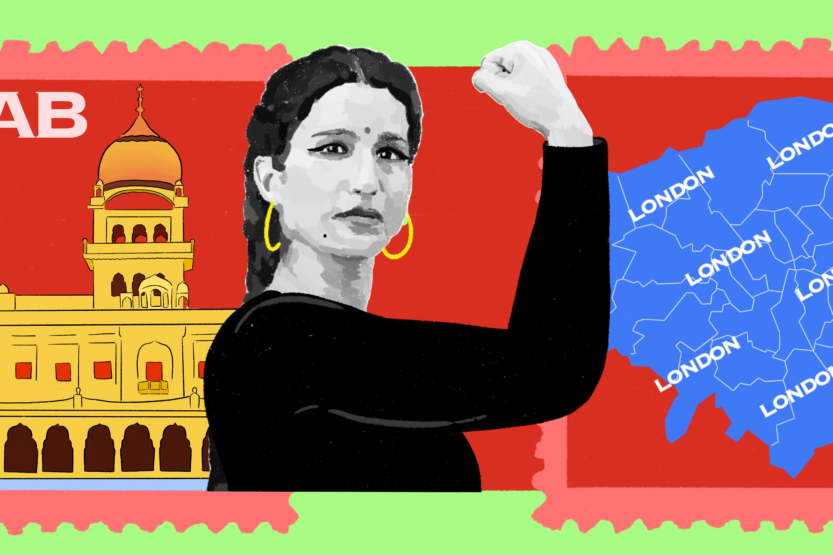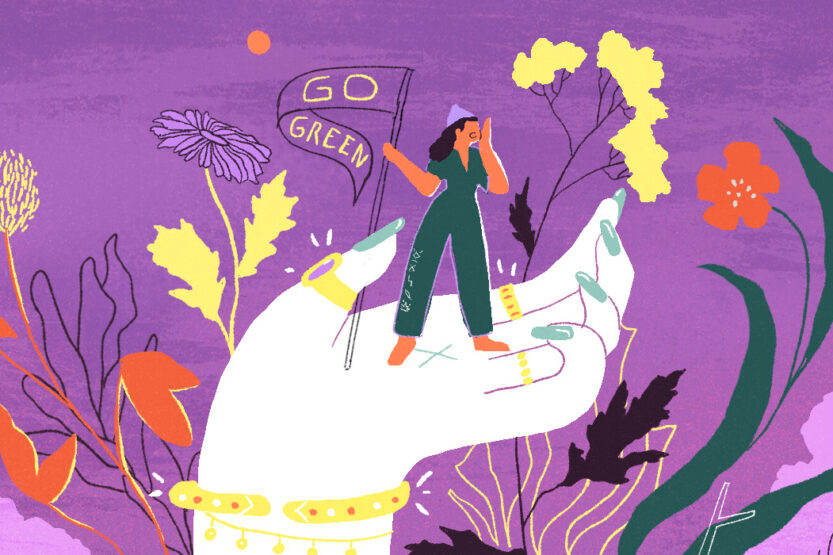Aromatic spices cloak the air, which is alive with the sounds of chattering voices, the rhythmic chopping of knives on boards and the sizzling of cumin and garlic in hot oil. The kitchen surfaces are crowded; each hob is occupied by different sizes of pots and pans. Green and black split lentils are washed, rinsed and placed in the pressure cooker. It’s a spring evening in Kent and my mother and I are cooking our usual dinner, a staple in Nepali households – dal bhat.
Back home in Dharan, we grew up eating dal bhat almost every day. In a nation where over 125 ethnic groups exist, there is a rich and diverse culinary heritage and food culture with regional varieties, such as in my Kirat community. And while dal bhat is technically Khas cuisine, it’s considered a staple dish across all Nepali diets.
Like a thread, dal bhat connects many Nepali households through time and place, from the open dining room in my home in Dharan where my cousins, sisters, aunties and I would come together to eat, to the evenings after work where my family and I share the same daily meal today, thousands of miles away from home.
I enjoy making my favourite aachar, a Nepali pickle chutney crushed together in a pestle and mortar using fresh chillies, tomatoes, salt and coriander, the pungent notes of the chillies immediately hitting me. My mother picks rayo saag, leafy mustard greens, from the garden. The plant is indigenous to Nepal, its seeds brought over from back home by Nepali aunties and relatives to be carefully planted for harvest in early spring.
‘Dal-bhat’ power
Dal bhat is traditionally meat-free and consists of a lentil soup, rice and cooked vegetables. It’s a fulfilling, inexpensive meal of which there are countless variations. My mother’s family, who lived in the hilly region of Nepal, grew up eating the meal with cornmeal instead of white rice, as maize, an ancient grain, was native to their region. When my mother tells me about her childhood meals, it’s with a warm nostalgia. They made sustainable food choices, locally available within the community, and eaten according to the local region and seasons.
Indeed, many staples of Nepali cuisine are vegan and sustainable – for example, soybean, which is where tofu and other plant-based foods derive from, is considered one of Nepal’s oldest crops. But I didn’t appreciate this important part of my heritage until I became plant-based for ethical reasons, inspired by western trends and influencers in the mid-2000s.
Tumblr era of veganism
I grew up watching and following the lifestyle advice of vegan YouTubers such as Essena O’Neill and Stella Rae. I watched short documentaries such as Earthlings and Cowspiracy; I emailed animal rights activists such as Gary Yourofsky; I even attempted to eat 10 bananas at once as advocated by controversial vegan blogger, Leanne Ratcliffe (popularly known as Freelee the banana girl). However, I didn’t realise I was favouring a Eurocentric perception of veganism all along.
While I was trying out Tumblr’s favourite banana ‘nicecream’, smoothie bowls, raw salad recipes and expensive “superfoods” such as chia seeds, hemp seeds and goji berries, I was ignoring the fact that I was already eating traditional Nepali plant-based meals cooked by my family at home. I began to find Black, Indigenous, and People of Colour (BIPOC) content creators such as George Lee and Joanne Molinaro, also known as The Korean Vegan, advocating plant-based eating through their cultural dishes which framed a diverse perspective on what it means to be vegan, challenging the narrative of veganism as a white, western ‘phenomenon’.
Curious about Kirati culinary history, my appreciation grew as I learnt about how quintessential and nutritionally rich the sources of ethnic foods and meals are within my Kirati community. Learning about my ancestral dishes and enjoying traditional foods at home, I came to the realisation that plant-based eating has always been an inherent part of my culture and Indigeneity. I realised that it’s not ‘outside’ my culture to be plant-based, something I wish I embraced sooner such as when I first changed my eating habits.
Two Kirati delicacies, commonly eaten in Nepali diaspora households such as mine, are gundruk and kinema. They’re both fermented dishes – a practice which is common in Nepali culinary culture and believed to come from the ancestral practice of preserving food. Gundruk is prepared by fermenting sun-dried rayo saag. It has a mildly sour flavour and is often served in a soup with Nepali herbs, or as a pickle mixed with spices. Kinema is made from fermenting cooked soybeans. It has a pungent ammoniacal smell with umami flavours, seasoned with garlic, chilli and turmeric and served as a soup dish with fresh herbs.
BIPOC roots of plant-based culture
With time came maturity – initially exploring veganism outside of my culture, it was time to look within. I began to question the Eurocentric lens on what we eat and in the process, understood the rich Nepali culture of plant-based foods. I further drew an interest in cooking Nepali food at home as I learnt about the many herbs and greens my mother grew in the garden and included in our dishes. I began to enjoy cooking Nepali dishes and embraced my identity through food, learning about the typical ingredients and spices used and most importantly, enjoying it with my family.
In fact, the resurgence of plant-based eating in the west is pointing to a direct return for BIPOC to embrace their Indigeneity and their roots. While meat-free diets started to become popular in the UK and the US from the 1960s, plant-based diets originated from communities of colour around the world thousands of years ago, including from African, Indigenous, Asian, and Caribbean cultures.
Ancient civilisations such as the Mayans and the Indus Valley cultivated plant-based diets, where Eastern religions such as Buddhism, Hinduism and Jainism centre the philosophy of ‘ahimsa’ (non-violence) and therefore have promoted plant-based diets for decades. Rastafarianism, a religious and social movement that originated in Jamaica during the 1930s, advocates natural living and a particular way of eating known as ‘Ital’ – which stems from the word ‘vital’ – and is both a health conscious and spiritual decision to build a closer connection to nature.
Celebrating your identity starts from home
Whereas these religions and philosophies continue to thrive in the modern age, mainstream perceptions of a plant-based diet in the west often portray a one-dimensional image of health, wealth and whiteness. This is extremely unrepresentative of the diverse communities who are plant-based and carry its historical and cultural lineage; as a result, modern conversations around being plant-based tend to erase BIPOC voices from the conversation completely
BIPOC communities such as LION (Land In Our Names) are reimagining a close relationship to the land that exists beyond ‘dynamics of extraction’ through distribution of BIPOC land stewardship and hence, disrupting colonial-rooted powers of land ownership in Britain. Through story-telling, workshops and events with opportunities to connect to the land, they are fostering the narrative of land as a place of community, growth and care, and not simply a ‘resource’. At home, helping outside in my mother’s garden and seeing the fruits of my mother’s labour has taught me the endeavour of growing organic, as well as the resilient care required for the land to thrive.
It’s undeniably true that upbringing and cultural identity shape the food we eat. For many Indigenous communities such as my Kirat ancestors and community, there’s a historical and cultural connection to, and knowledge about, organic foods due to our strong connection to the land.
Re-discovering the rich and diverse culinary practices of my Kirat ancestors has inspired me to celebrate my food culture as one which has travelled far from home and throughout many generations. Through consuming ancestral dishes and learning about their history, I realise that I’m embracing a decolonial mindset – and I am now able to embrace how a philosophy of sustainable living remains true to my culinary roots and has always been a part of home.
What can you do?
Books on plant-based food and culture by people of colour:
- Timmur: Stories and Flavours from Nepal by Prashanta Khanal
- The Korean Vegan by Joanne Molinaro
- Afro-Vegan by Bryant Terry
Articles on Kirat food culture:
Support modern Nepali-owned restaurants in the city:
Subscribe to shado's weekly newsletter
Exclusive event news, job and creative opportunities, first access to tickets and – just in case you missed them – our picks of the week, from inside shado and out.

Support BIPOC voices reclaiming veganism – recipes and articles:
- Isaias Hernandez, environmental educator and founder of Queer Brown Vegan
- Joanne Molinaro, author of The Korean Vegan
- George Lee, Taiwanese cook and food blogger
Further resources:
- LION Resource pack on growing food and land justice
- Read other articles on food HERE
